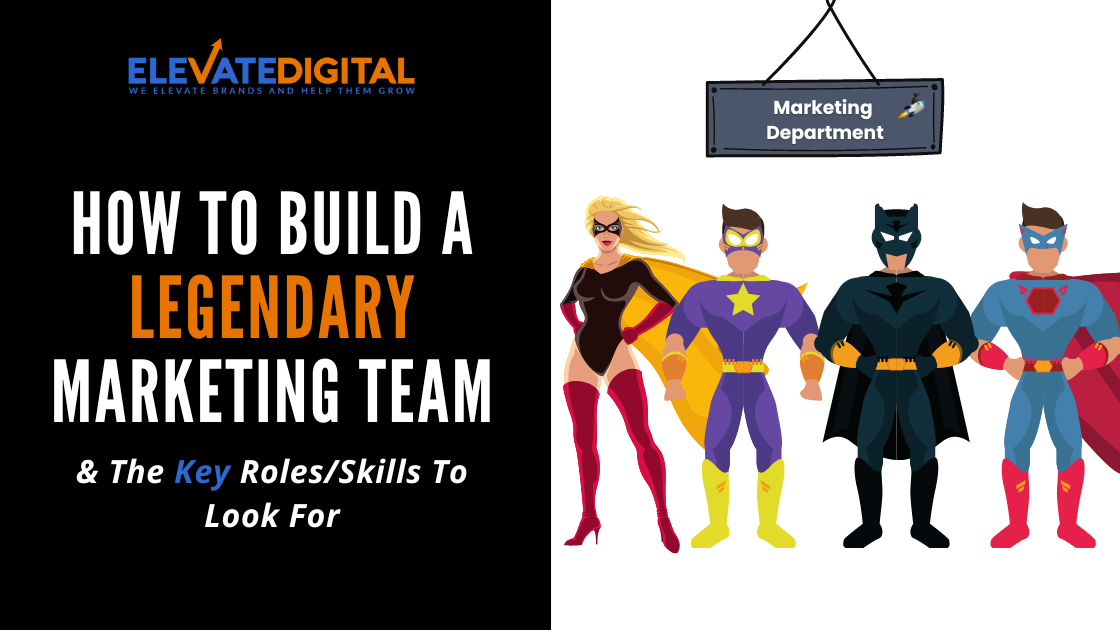If only there was a secret “hack” for creating an high-performing marketing team.
Alas, there is not…
But that doesn’t mean we can’t help you start building your own team of marketing rockstars!
To start, you need to identify the different roles needed and then create a structure for your team.
Wondering what those roles might be? And who should lead the team?
This blog post will help answer those questions and give you a structure for your marketing team. Let’s get started!
What Does A Marketing Team *Actually* Do?
In a nutshell, a marketing team is responsible for a company’s public image and the promotion of its products or services.
However, in order to do this effectively, they must first intimately understand the needs and wants of their target audience. Once they have a clear understanding of who they are marketing to, they can develop an effective strategy.
This will involve planning and executing various marketing campaigns, as well as monitoring their progress and making adjustments where necessary. The ultimate goal of a marketing team is to increase brand awareness and generate more sales. However, in order to be successful, they must constantly adapt to the ever-changing landscape of the marketing world.
The Obsolete Marketing Team Structure
Most marketing teams are structured purely based on marketing “disciplines” which unfortunately keeps many businesses stuck in a feast and famine cycle…
For example, you’ll have your paid ad specialists or your SEO specialists, and their entire focus would be on generating more traffic and more sales.
Sounds great on paper right?
The issue is, SEO’s would be targeted on simply getting the MOST possible traffic (regardless of search intent) and paid marketers are targeted with simply getting the cheapest leads possible.
But what’s the problem with that you might ask?
Well it means in order to hit targets, marketers (in any discipline) were forced into activities that generate as many leads or visitors as possible regardless of quality – instead of taking into account the way people ACTUALLY buy today, thus taking the time to create demand, nurture prospects and build a pipeline of high value, qualified buyers.
This is one of the biggest reasons there is such a divide between sales and marketing teams!
Because marketing are incentivised to get the cheapest leads who often have ZERO intent to buy. Yet sales on the other hand are incentivised to CLOSE deals, so naturally get annoyed when calling customers who never answer or have any intent to buy.
The Innovative Way To Build A Marketing Team
As people have become more resistant to traditional forms of advertising, it has become necessary to split marketing teams into two distinct groups: those focused on top-of-funnel activities like demand generation and brand building and those focused on bottom-of-funnel activities like demand capture and direct response.
Whether you’re in B2B or B2C, the fact is, buyers have become more and more resilient to marketing. This means businesses end up fighting over scraps of the customers who are ready to buy right now. However, because this pool is so competitive, you’ll often end up with very high cost per acquisition and campaigns that barely scrape a profit.
In order to generate outsized returns, you need to use your marketing budget to educate buyers at the top of the funnel and bring them “in-market” leaving your company as the logical choice.
The issue here is that you can’t measure demand generation in the same way as you measure demand capture.
So by having your teams split between demand generation and demand capture, it allows each team to be incentivised appropriately and ensures that all aspects of the marketing funnel are given the attention they deserve.
For example, a top-of-funnel team might be responsible for generating awareness of a new product through paid advertising, PR, and content marketing, and subsequently be measured on the number of successful tests by finding positive signs in content engagement. On the other hand, a bottom-of-funnel team would be responsible for conversion rate optimisation and lead nurturing.
By splitting teams into these two groups, businesses can ensure that all aspects of their marketing are given the attention they need to succeed.
Top-Of-Funnel Marketing Or Demand Generation Team
A top-of-funnel team is responsible for providing the buyer with relevant, meaningful information about your product or service. This is the stage when we want to understand specific buyer triggers. The goal of TOF/demand-gen teams is to generate interest in the product or service among the target audience so that they can eventually be converted into customers.
Some examples of TOF marketing activities include content marketing (e.g. blog posts, infographics, ebooks), SEO, social media marketing, and lead nurturing. By producing quality content that educates and informs the buyer, top-of-funnel teams can increase brand awareness and build trust with potential customers.
The KPIs for top-of-funnel teams may include measures such as how many comments they received from their ideal customer (no, your mum or best friend doesn’t count), how many social shares they received, and whether their branded search traffic increased. By tracking these metrics, TOF teams can gauge the success of their efforts in generating leads and interest in the product or service.
Bottom-Of-Funnel Marketing Or Demand Capture Team
A bottom-of-the-funnel marketing team’s job is to close the deal with potential customers who have already shown a high level of interest in what you have to offer. They do this by focusing on key performance indicators (KPIs) such as lead conversion rates, cost per acquisition, and buyer journey optimisation. In other words, their goal is to turn interested prospects into paying customers.
There are a number of different strategies that bottom-of-the-funnel teams use to achieve these objectives. One common tactic is retargeting ads, which are designed to reach people who have already visited your website or shown an interest in your product or service. Another common strategy is offering free trials or demos, which can help to seal the deal with potential customers who are on the fence about whether to buy.
In order to generate leads, BOF teams use a variety of marketing tactics such as targeted ads, emails, and webinars. Once a lead is generated, the BOF team works to convert that lead into a customer. This involves nurturing the lead with additional content and resources to help them make purchasing decisions. Finally, once a sale is completed, the BOF team focuses on optimising the buyer journey to ensure that customers have a positive experience and are likely to buy again in the future.
How To Identify Roles For Your Marketing Team?
There’s no one-size-fits-all answer to this question, as the roles you’ll need on your marketing team will vary depending on a number of factors, including the size of your company and the platforms you’re targeting your audience on. However, there are a few key things to keep in mind that will help you identify the roles you need.
For example, if you’ve identified that your audience is primarily active on visual platforms like Facebook and Instagram, it’s likely that you’ll need an in-house creative/design team to produce high-quality content that will resonate with users. On the other hand, if you’re targeting a more professional audience on LinkedIn, you’ll probably want to focus on building a team with strong writing and editing skills.
No matter what platform you’re targeting, it’s also important to have team members who are well-versed in digital marketing strategy and can create campaigns that are designed to achieve specific business goals.
If you are not sure where to start while building a marketing team, these are a few basic roles you need to have people in, to build an effective marketing team:
Strategist
A strategist is someone who is responsible for developing and overseeing the overall marketing strategy for a company. They work to create campaigns that will generate awareness and interest in the company’s products or services. In addition, strategists also work to evaluate customer data and trends in order to determine the best ways to reach target audiences. Without a strategist, it would be very difficult to develop and execute an effective marketing plan.
Copywriter
A copywriter is a wordsmith, a magician with semantics. He weaves together the fabric of your marketing campaigns, stitching your product’s story into the minds of the consumer. He’s the one who tells the world why your product is worth their time, their money, their investiture. A copywriter is essential for any marketing team because he is the champion of your product, the knight in shining armour that will slay the dragon of public opinion and make your company the hero.
In simple words..
A copywriter is someone who writes the words that go into advertisements, brochures, and other marketing materials. A good copywriter can make a big difference in the effectiveness of a marketing campaign, and that’s why they’re an essential component of any good marketing team.
A copywriter’s job is to create persuasive, attention-grabbing copy that will convince people to take the desired action. This can be anything from buying a product to signing up for a newsletter. To be effective, the copy must be well-written, clear, and on-brand. It also needs to be tailored to the specific audience.
Creative/Graphic Designer
A Graphic Designer is a necessary component of your marketing team because they are responsible for creating visual content that represents your brand. Graphic Designers use their creativity and technical skills to design layouts, create logos, and produce stunning visual graphics that capture the attention of your target audience.
In addition to their creative talent, Graphic Designers also deeply understand colour theory, typography, and composition. This knowledge allows them to create visually appealing designs that communicate your marketing message effectively. Without a Graphic Designer on your team, you would be missing an essential piece of the puzzle.
Web Developer
Web developers are responsible for creating and maintaining websites, as well as ensuring that they are easy to use and accessible to a wide audience. They also play a vital role in ensuring that the website’s performance is up to par and that it can handle large amounts of traffic.
In addition, web developers are often responsible for implementing search engine optimisation (SEO) strategies, which can help to increase a website’s visibility and attract more visitors.
Social Media/Community Manager
A social media manager is a necessary component of your marketing team for several key reasons. First, they are responsible for creating and managing content across all of your social media channels. This includes everything from writing posts and crafting headlines to curating images and developing video content.
In addition, social media managers also play a vital role in promoting your brand and engaging with your audience. They monitor comments and mentions, responding to questions and concerns in a timely manner. They also work to grow your following by identifying influencers and key opinion leaders in your industry. Without a social media manager, it would be nearly impossible to effectively market your business on social media.
How To Scale Your Marketing Team Over Time?
As your company grows, so will the need for marketing support. But how do you know when it’s time to expand your marketing team? And how can you ensure that your new hires are set up for success?
One way to tell if it’s time to expand your marketing team is to track the number of leads that they’re generating. If you’re seeing a consistent increase in the number of leads over time, it may be time to add some additional support. Another thing to keep an eye on is the quality of those leads. If you’re getting more inquiries, but they’re from unqualified prospects, you may need to invest in some additional market research or lead generation activities.
Once you’ve decided that it’s time to expand your marketing team, the next step is to identify the skills and experience that you need. Do you need someone with a background in copywriting? Or someone who’s an expert in social media marketing? Once you’ve determined the skillset that you need, take some time to write out detailed job descriptions. This will help ensure that you attract the right candidates when you start your search.
Scaling your marketing team doesn’t have to be daunting. By staying attuned to your company’s needs and taking a thoughtful approach to hiring, you can build a team that will help take your business to the next level.
Conclusion
So, there you have it – a basic blueprint for how to structure your marketing team and identify the roles they will play. Of course, every business is different, and you may find that you need to tweak this model to fit your specific needs. That’s okay!
The most important thing is that you start with a solid foundation and then build on it as your company grows. And if you ever get stuck or need help scaling your marketing efforts, don’t hesitate to reach out to us. We’d be happy to chat with you about how we could help take your marketing strategy to the next level. Thanks for reading!
Want To Skyrocket Your Website Conversion Rate?
Book your FREE website and marketing review today and we’ll record you a 15-minute personalised video showing you how to increase your traffic, leads AND sales.
- 10 Highly Effective B2C Marketing Ideas & Strategies - April 10, 2023
- How To Create A Legendary Marketing Team In 2022 - October 10, 2022
- Which Ad Platform Is Best In 2024 - May 17, 2022





